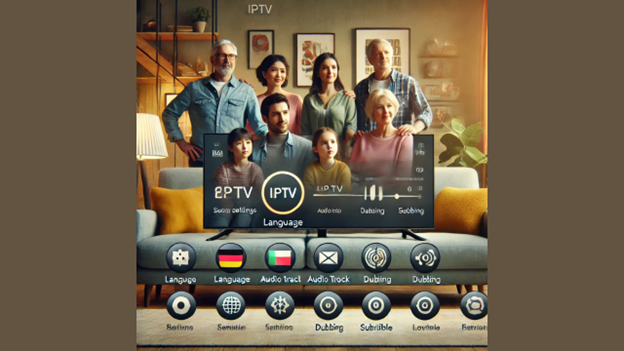In today’s multicultural world, many households are multilingual—where parents, grandparents, and children speak different languages or dialects. This linguistic diversity brings vibrancy to daily life but often presents a challenge when it comes to entertainment. Standard cable or streaming services rarely cater to these layered needs, leaving viewers to juggle between platforms or compromise on language preferences.
This is where IPTV (Internet Protocol Television) steps in. With advanced features like subtitles, dubbing, and multi-audio support, IPTV is quickly becoming the go-to solution for families looking to accommodate everyone’s linguistic preferences. For example, iptv telugu channels now often include subtitle options or dubbed versions of programs, making it easier for multilingual households to enjoy content together—without language being a barrier.
Why Language Support Matters in Entertainment
Language is more than just a communication tool—it’s a key to emotional resonance. Watching a show in your native language enhances comprehension, connection, and cultural relevance. For households that speak Telugu, Malayalam, Hindi, Tamil, or other Indian languages, accessing content in those languages can significantly elevate the viewing experience.
Multilingual households often include:
- Children raised in English-speaking environments
- Elderly parents more comfortable in native languages
- Spouses from different linguistic backgrounds
- Family guests with different language needs
Without language support, finding shows or movies everyone can enjoy becomes nearly impossible. IPTV changes that by offering an ecosystem where content isn’t just available—it’s adaptable.
Subtitle Support: Bridging Generational and Linguistic Gaps
Subtitles are one of the most powerful features IPTV offers to multilingual homes. They help in:
1. Language Learning
Children or spouses trying to learn another household language can watch content in one language while reading subtitles in another.
2. Improving Comprehension
Seniors with hearing challenges or viewers unfamiliar with specific dialects can follow content easily with accurate subtitles.
3. Cross-Language Entertainment
Imagine watching a Telugu movie with English subtitles, or a Malayalam devotional show with Hindi captions. IPTV platforms make this possible.
IPTV providers often let users toggle subtitle tracks on or off and select their preferred language, offering a seamless and customized experience.
Dubbing Options: A Familiar Voice in a New Language
Dubbing allows audio to be replaced in another language, preserving visual content while adapting the dialogue. This is especially useful for children or non-native speakers who find it difficult to read subtitles.
For instance, a Malayalam movie dubbed in Telugu can bring families together for movie night—even if only one person speaks Malayalam natively. Services like malayalam iptv increasingly offer such multi-language support to expand reach and inclusivity.
Benefits of IPTV dubbing features:
- Inclusive Family Viewing
- Easier Access for Illiterate Viewers
- More Enjoyable for Young Children
Some IPTV platforms also allow users to switch between original and dubbed audio in real time, giving full control over the experience.
Multi-Audio Features: Flexibility on Demand
Multi-audio support is where IPTV truly shines. Unlike traditional TV that forces you to watch in one fixed language, IPTV often provides several audio tracks per program. Users can switch languages during playback without restarting or exiting the content.
This is especially useful for:
- Mixed-Language Families: Each member can watch the same show in their preferred language.
- Cultural Holidays and Gatherings: Guests can enjoy regional content regardless of their native tongue.
- Language Learners: Switching back and forth helps in active listening and comprehension.
Premium IPTV services usually display available audio tracks upfront, so you know what options are available before you start watching.
Real-World Use Case: A Multilingual Indian Family in the U.S.
Let’s take the example of a Telugu-Malayalam bilingual household based in New Jersey:
- The grandparents primarily speak Telugu.
- The parents are fluent in Malayalam and English.
- The kids understand English better but are learning both Telugu and Malayalam.
With a traditional cable setup, this family would have to juggle between different services—or worse, miss out on regional content altogether.
With IPTV:
- Grandparents can access iptv telugu channels with Telugu audio and subtitles.
- Parents can enjoy Malayalam devotional and news programs with audio in their language.
- Kids can watch cartoons dubbed in English with subtitles in Malayalam to practice language skills.
IPTV not only caters to their needs but also brings the family together through shared experiences.
Accessibility for Seniors and Children
IPTV’s language features are particularly valuable for the most vulnerable audiences—elderly and children.
- Seniors: Can enjoy content in their native tongue without learning new devices or navigating complex menus.
- Children: Can consume content in familiar voices or subtitles tailored to their comprehension level, promoting bilingual growth.
With intuitive remotes, voice search, and personalized interfaces, IPTV reduces barriers and enhances daily life.
Selecting the Right IPTV Service for Multilingual Needs
If you’re part of a multilingual household, here’s what to look for:
- Multi-Language Audio Support
- On-Screen Subtitles with Multiple Language Tracks
- Dubbed Content Libraries
- Regional Channel Bundles (e.g., Telugu, Malayalam, Hindi)
- Flexible Language Switching During Playback
- Mobile and TV App Support for Various Devices
Services like Indians IPTV have made huge strides in delivering regional Indian content with these essential features, serving families around the world.
Future Trends in Language Personalization
As IPTV evolves, we can expect even more intelligent language-based features such as:
- AI-Generated Subtitles in Real-Time
- Dynamic Dubbing Using Voice Cloning
- Family Profiles with Saved Language Preferences
- Instant Language Switch for Live Programming
- Multi-Device Language Syncing
These innovations will further personalize content delivery, creating an inclusive and adaptive home-viewing experience.
Conclusion
For multilingual households, entertainment has always come with compromises. But IPTV is rewriting the rules—making it easier, more accessible, and far more enjoyable for families speaking different languages under one roof.
Through smart features like subtitles, dubbing, and multi-audio support, IPTV ensures that no one gets left out. Whether you want to enjoy devotional content in Malayalam or a drama series in Telugu, IPTV offers seamless solutions tailored to every viewer’s preference.
With services like Indians IPTV, the future of regional, multilingual, and family-friendly entertainment is already here—on your screen, in your language, and always on demand.
FAQs
1. Can I switch audio languages while watching a show on IPTV?
Yes. Most IPTV platforms support multi-audio features, allowing you to change the language during playback.
2. Are subtitles available for all IPTV content?
Not all content has subtitles, but many regional and international shows offer multi-language subtitle options.
3. Is dubbed content available on IPTV?
Yes. Many programs, especially regional movies, come with dubbed audio in various languages for broader accessibility.
4. Is IPTV good for teaching kids multiple languages?
Absolutely. Kids can watch cartoons or shows in one language with subtitles in another, helping them learn both passively and actively.
5. Which IPTV provider offers the best multilingual features?
Platforms like Indians IPTV are known for their regional language support, including Telugu and malayalam iptv, and are highly recommended for multilingual households.



